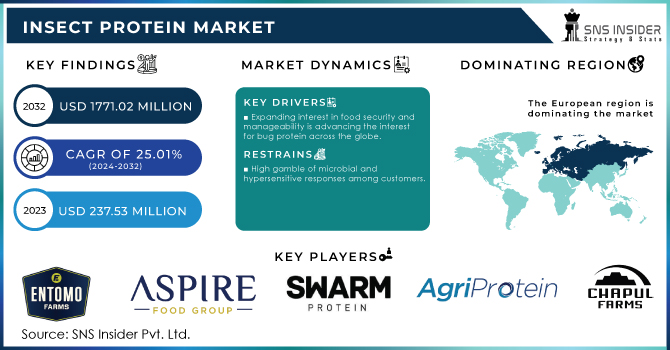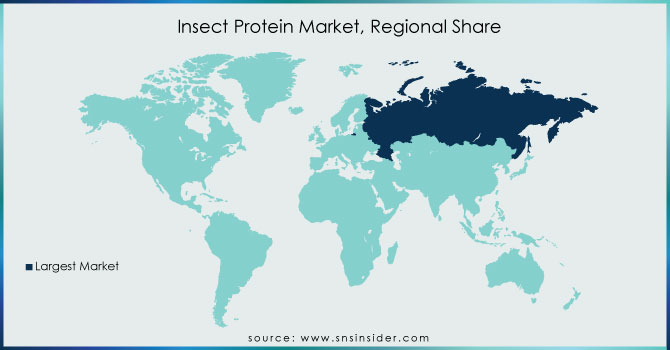Insect Protein Market Report Scope & Overview:
The Insect Protein Market size was valued at USD 237.53 million in 2023 and is expected to reach USD 1771.02 million by 2032 and grow at a CAGR of 25.01% over the forecast period of 2024-2032.

Get more information on Insect Protein Market - Request Sample Report
Insect protein is an excellent protein that is accessible in fluctuated structures, for example, Insect protein powder and Insect protein creature feed. Insects, plants, miniature creatures, and a few types of fish produce radiator fluid proteins. Entire Insects, flour, and oil are the most usually utilized Insect protein items types.
The developing purchaser mindfulness in regards to the utilization of nourishing food items and expanding inclination for a solid way of life is supposed to drive the interest for Insect protein over the conjecture time frame. The developing well-being awareness among shoppers across the globe has expanded the interest for solid and nutritious food items, consequently giving open doors to makers in different ventures to offer such food items.
There is a standard handling system for animals yet there is none for the Insects, consequently, this gives a colossal open door to the makers to gadget an innovation or gear that can help in the handling of the Insect with standard convention in the Insect protein market. The utilization of Insect protein by an individual having arthropod sensitivities could bring about cross response or responsiveness. Furthermore, regular openness to Insects during cultivating or rearing may likewise prompt contact sensitivity in person which is one of the significant tests looked at by the assembling firm in the Insect protein market.
This Insect protein market report gives subtleties of the portion of the overall industry, new turns of events, and item pipeline examination, the effect of homegrown and confined market players, investigations of potential open doors as far as arising income pockets, changes in market rules, thing supports, key decisions, thing dispatches, geographic turns of events, and mechanical headways keeping watch.
Market Dynamics:
Driving Factors:
-
Expanding interest in food security and manageability is advancing the interest for bug protein across the globe.
Restraining Factors:
-
High gamble of microbial and hypersensitive responses among customers.
Opportunities:
-
Characterized guidelines and arrangements by government offices.
Challenges:
-
Critical development in the vegetarian populace across the globe.
Impact of Covid - 19:
The effect of COVID 19 has impacted most nations across the world. Lockdowns, inferable from COVID-19 antagonistically impacted the worldwide Insect protein market development. The pandemic prompted a few difficulties in the food area; the meat market has been ineffectively hit worldwide. The gamble of persistent creation, supply, dispersion, absence of labor force, and lesser improvement exercises have concerned the Insect feed market. On 11 March 2020, WHO portrayed the COVID-19 flare-up as a pandemic in the wake of spreading to 112 nations. Therefore, a possible change in purchasers' food decisions could happen, especially concerning the food of the creature beginning. Subsequently, it is projected that there will be a higher dismissal to devour surprising food sources of creatures beginning with Insects. On account of Insects utilized for food and feed, there are likewise worries about the gamble of transmission of zoonotic contaminations to people. Insects are known to help diseases and sully individuals through direct blood mixture; notwithstanding, it has not been accounted for that these infections can be sent through ingestion.
Key Market Segmentation:
By Insect:
- Beetles
- Caterpillars
- Bees, Wasps, and Ants
- Grasshoppers, Locusts, and Crickets
By Form:
- Whole Insect
- Powder
By Application:
- Food & Beverages
- Animal Nutrition
- Aquafeed
- Pet Food
- Poultry Feed
- Pharmaceuticals & Cosmetics
By application, the F&B area held the top situation all through the survey period. The predominance of Insect protein, similar to more or tantamount amounts of protein as well as absorbability to other Animal and Plant proteins, has been continually expanding its interest in the F&B area.
Also, consistent advancements on the lookout, similar to MOM's Organic Market created many cricket and mealworm protein-based things, similar to cricket treats, mealworm Bolognese and mass combination of Insects, have been supporting its market deals.
Be that as it may, in the figure time frame, its interest in Animal feeds is projected to be the most noteworthy. Recognition of its utilization from government bodies is further heightening its interest. For example, European Commission formally supported the utilization of Insect protein as another feed type of hydroponics feed. Endorsement by the European Commission followed by the CFIA endorsement of the purpose of Insects as a constituent in Salmon feed.
Regional Analysis:
The European market has a higher buyer acknowledgment rate for Insect protein for applications like the food and drink industry, creature sustenance, and individual consideration industry. North America represented a critical income share in 2020. The market is supposed to be the biggest market by 2028 attributable to the interest for healthful food items and developing mindfulness among the buyers in regards to the utilization of Insect based products.
The Asia Pacific district is supposed to extend at an income-based CAGR of 29.05% over the estimated period inferable from the developing purchaser base in the nations, including India, China, and Thailand. Additionally, nations, such for example, Thailand and Indonesia have a long history of Insect utilization and are among the enormous makers of Insects adding unrefined substances.

Get Customized Report as per your Business Requirement - Ask For Customized Report
Regional Coverage:
-
North America
-
The USA
-
Canada
-
Mexico
-
-
Europe
-
Germany
-
The UK
-
France
-
Italy
-
Spain
-
The Netherlands
-
Rest of Europe
-
-
Asia-Pacific
-
Japan
-
south Korea
-
China
-
India
-
Australia
-
Rest of Asia-Pacific
-
-
The Middle East & Africa
-
Israel
-
UAE
-
South Africa
-
Rest of Middle East & Africa
-
-
Latin America
-
Brazil
-
Argentina
-
Rest of Latin America
-
Key Players:
Some of listed players included in this report are, EntomoFarms, Aspire Food Group, Chapul Cricket Protein, Swarm Nutrition GmbH, AgriProtien Holdings Ltd., InnovaFeed SAS, Protix, Insect, EnviroFlight LLC, Hexafly Company.
| Report Attributes | Details |
|---|---|
| Market Size in 2023 | US$ 237.53 Million |
| Market Size by 2032 | US$ 1771.02 Million |
| CAGR | CAGR 35.01% From 2024 to 2032 |
| Base Year | 2023 |
| Forecast Period | 2024-2032 |
| Historical Data | 2020-2022 |
| Report Scope & Coverage | Market Size, Segments Analysis, Competitive Landscape, Regional Analysis, DROC & SWOT Analysis, Forecast Outlook |
| Key Segments | • by Source (Coleoptera, Orthoptera) • by Application (Animal Nutrition, Food & Beverages) |
| Regional Analysis/Coverage | North America (USA, Canada, Mexico), Europe (Germany, UK, France, Italy, Spain, Netherlands, Rest of Europe), Asia-Pacific (Japan, South Korea, China, India, Australia, Rest of Asia-Pacific), The Middle East & Africa (Israel, UAE, South Africa, Rest of Middle East & Africa), Latin America (Brazil, Argentina, Rest of Latin America) |
| Company Profiles | EntomoFarms, Aspire Food Group, Chapul Cricket Protein, Swarm Nutrition, GmbH, AgriProtien Holdings Ltd., InnovaFeed SAS, Protix, Insect, EnviroFlight LLC, Hexafly Company. |
| Key Drivers | •Expanding interest in food security and manageability is advancing the interest for bug protein across the globe. |
| Restraints | •High gamble of microbial and hypersensitive responses among customers. |

